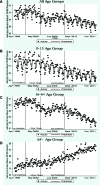Impact of the SIGN head injury guidelines and NHS 4-hour emergency target on hospital admissions for head injury in Scotland: an interrupted times series
- PMID: 30580260
- PMCID: PMC6318526
- DOI: 10.1136/bmjopen-2018-022279
Impact of the SIGN head injury guidelines and NHS 4-hour emergency target on hospital admissions for head injury in Scotland: an interrupted times series
Abstract
Objectives: Head injury is a common reason for emergency department (ED) attendance. Around 1% of patients have life-threatening injuries, while 80% of patients are discharged. National guidelines (Scottish Intercollegiate Guidelines Network (SIGN)) were introduced in Scotland with the aim of achieving early identification of those with acute intracranial lesions yet safely reducing hospital admissions.This study aims to assess the impact of these guidelines and any effect the national 4-hour ED performance target had on hospital admissions for head injury.
Setting: All Scottish hospitals between April 1998 and March 2016.
Participants: Patients admitted to hospital for head injury or traumatic brain injury (TBI) diagnosed by CT imaging identified using administrative Scottish Information Services Division data. There are 275 hospitals in Scotland. In 2015/2016, there were 571 221 emergency hospital admissions in Scotland.
Interventions: The SIGN head injury guidelines introduced in 2000 and 2009. The 4-hour ED target introduced in 2004.
Outcomes: The monthly rate of hospital admissions for head injury and traumatic brain injury.
Study design: An interrupted time series analysis.
Results: The first guideline was associated with a reduction in monthly admissions of 0.14 (95% CI 0.09 to 4.83) per 100 000 population. The 4-hour target was associated with a monthly increase in admissions of 0.13 (95% CI 0.06 to 0.20) per 100 000 population. The second guideline reduced monthly admissions by 0.09 (95% CI-0.13 to -0.05) per 100 000 population. These effects varied between age groups.The guidelines were associated with increased admissions for patients with injuries identified by CT imaging-guideline 1: 0.06 (95% CI 0.004 to 0.12); guideline 2: 0.05 (95% CI 0.04 to 0.06) per 100 000 population.
Conclusion: Increased CT imaging of head injured patients recommended by SIGN guidelines reduced hospital admissions. The 4-hour ED target and the increased identification of TBI by CT imaging acted to undermine this effect.
Keywords: Nhs 4-hour emergency department performance target; head injury; interrupted time series; sign guidelines; traumatic brain injury.
© Author(s) (or their employer(s)) 2018. Re-use permitted under CC BY. Published by BMJ.
Conflict of interest statement
Competing interests: None declared.
Figures
References
-
- NICE. National Clinical Guidance Centre. (2014). CG 176 head injury triage, assessment, investigation and early management of head injury in children, young people and adults. UK: DOH: National Institute for Health and Care Excellence, 2014. edn. - PubMed
-
- SIGN Guideline 110. Early management of a patient with a head injury: a national clinical guideline. 2009.
Publication types
MeSH terms
Grants and funding
LinkOut - more resources
Full Text Sources
Medical
Miscellaneous


